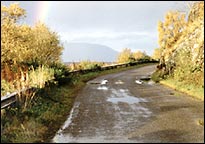
December 22, 2007
The Water Horse Land Sightings at Loch Ness

On this section of the autoway around Loch Ness, an eyewitness once saw an unknown creature cross the road.
The dirty little secret that drives two groups – the closed minded debunkers and the plesiosaur true believers – totally mad is the file on land sightings of cryptids at Loch Ness. Some researchers would just as soon completely ignore them versus looking at what the encounters mean if they are evidence of cryptids unknown in and out of the Scottish lake.
The usual reaction has been one in which ridicule is used when talking about the land sightings. For example, the following cartoons, even if well-done and humorous, have been posted in conjunction with discussions of the two more famous Loch Ness land sightings of 1933 and 1934:
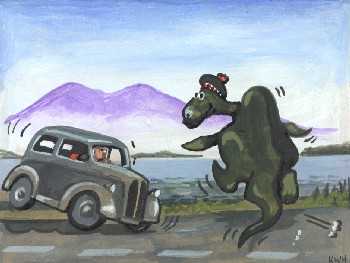
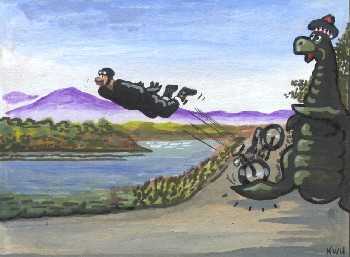
A Loch Ness Monster skeptic once asked me, “Do you really believe the land sightings?”
I answered him directly, per usual, this way: You shock me, as you must know that I don’t “believe” in anything to do with Loch Ness cryptids, as that word speaks more to religious fervor and blind evangelical faith, which I feel has little place in cryptozoology, except to characterize how some “researchers” approach the subject.
I accept that patterns develop from looking at the data. Indeed, it continues to amaze me that the “Nessie skeptics” refuse to be open-minded about looking at all the sightings, in an attempt to learn where the information might take one in examining and analyzing the available data on this probable natural history phenomenon.
Okay, I’m not sure what to make of some of the “land sightings” at Loch Ness, but I am not for throwing them all out with the bath water, that’s for sure.
Obviously, what appears in my and Patrick Huyghe’s book The Field Guide to Lake Monsters, Sea Serpents, and Other Mystery Denizens of the Deep (NY: Tarcher/Penguin, 2003), gives my overview of what I think about this matter (US & UK).
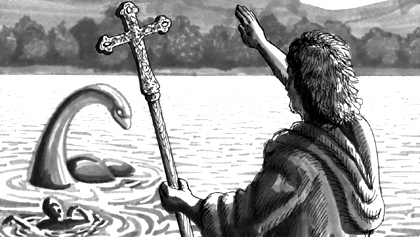
After the account by St. Columba in the 5th Century, which may or may not be technically a good, out-of-the-water sighting, I turned to the highlights of the history of Loch Ness land sightings.
Specifically, you will find on pages 80-83:
“In terms of the history of Lake Monsters, especially the Waterhorse, none outshines that of the Loch Ness Monsters, which naturally issue from the Water-kelpie traditions. While the history of Nessie is well known (see pages 18-22), less well known are the remarkable encounters with Nessies that have taken place on land. These accounts provide a close-up view of the Waterhorse, unobscured by murky waters.
“In 1771 someone spotted a monstrous creature ‘which was a cross between a horse and a camel’ near Loch Ness. Children playing at Ness’ Inchnacardoch Bay in 1912 told of seeing, from no more than a few yards’ distance, an animal that looked like a long-necked camel. It entered the water, then disappeared into the waves. Two other land reports at Loch Ness, from 1923 and 1933, compared the creature to a giant hippopotamus.
“Mike Dash, an investigator and author, has pointed out that one of the less-discussed topics about Loch Ness and Lake Monsters is the relatively modern history of over 20 land sightings at Loch Ness, and over 30 other such eyewitness accounts elsewhere. Land sightings, for example, are also known for creatures seen in Seljordsvatnet in Norway and Storsjøn in Sweden, as well as for several lakes in Ireland. Dash, an open-minded skeptic, feels that the paucity of land sightings since the thirties proves that the phenomenon of Nessie is more myth than monster. But a closer analysis of the data reveals that other factors may be at play.
“In April 1932, Colonel L. MCP Fordyce, came forth and told how he and his fiancée were traveling near Loch Ness, from Kent to Aberdeen, when they saw an enormous animal come out of the woods and cross the road about 150 yards ahead of their car. ‘It had the gait of an elephant, but looked like a cross between a very large horse and a camel with a hump on its back and a small head and long neck. From the rear it looked grey and shaggy. Apart from scanning the national papers for some time in search of mention of the creature, we let the matter rest.’
“Further confirmation, in the form of other land sightings, would come quickly during the next several months. In August 1933, Mrs. M.F. MacLennan saw a dark gray, humped animal with short, thick legs, on the beach near Dores. It appeared to be about 18 to 23 feet (6 to 7.5 meters) long. In December 1933, Mrs. Ried near Inverfarigaig saw a creature resting on shore about the size of a hippopotamus, with a hairy body, a thick mane on its neck, a round, large head, and with thick, short legs.
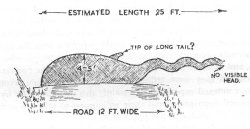
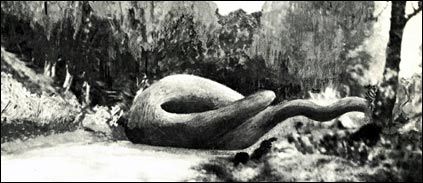
“Next came a classic sighting on par with the Spicers (see case, pp. 99-101). [Images of the Spicers’ sighting are above.] On the brightly moonlit night of January 5, 1934, at about 1:00 A.M., a young medical student named Arthur Grant was riding his motorcycle along the loch road near Lochend, when he saw a large dark object on the road ahead [images below]. As he approached, the animal ran across the road, almost colliding with Grant. In the moonlight, he saw an animal with a small eel-like head that had oval eyes, a bulky body with a broad tail, and four seemingly legs ending in flippers. He estimated it was about 18 to 20 feet long and had dark whale-like skin.
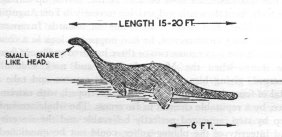

“‘Knowing something of natural history I can say I have never seen anything in my life like the animal I saw,’ Grant was quoted as saying in Peter Costello’s In Search of Lake Monsters. ‘It looked like a hybrid a cross between a plesiosaur and a member of the seal family.’
“Before 1933, the record shows land sightings of the Waterhorse of Loch Ness in 1527, 1879, 1880, 1890, 1912, 1919, and 1923. This would be seven in four hundred years. Some of the pre-1930s land sightings are spectacular, such as the 1880 Drumnadrochit encounter between E. H. Bright and a four-legged, long-necked, dark-grey monster that came out of a wooded area and went into the loch. Or the 1912 Inchnacardoch Bay encounter between William MacGruer and a yellowish, long-legged, camel-like beast that moved into the loch.
“But in general, most of the land sightings occurred in the 1930s – ten within two years, in fact. Why? As noted in the introduction, it happened just as the area was being deforested and the road around the loch was being upgraded. Views of the loch improved dramatically. Travel around the loch was easier. Media interest was at a peak. People were being forthcoming about what they were seeing–at least until the subject became a subject of ridicule both by the media and by scientists.
“During the 1930s, Alec Muir saw a large beast cross the road in front of his car at Inverfarigaig, and a group of school children saw what one of them called a ‘horrifying’ animal move from a swampy area to Urquhart Bay. Before the Spicer-Grant series of sightings, Mrs. Eleanor Price-Hughes told of seeing a large creature coming from the bushes with something pink (salmon?) in its mouth, and vanish into the water of the loch.
“During February 1934, a month after Grant’s sighting, Jean MacDonald and Patricia Harvey saw a thick-bodied creature that was more than six feet long crossing a stream near Inchnacardoch Bay in moonlight. It appeared to be dark above and lighter underneath, with four thick, short legs. In June 1934, Margaret Munro, at the shingle beach at Borlum Bay, sighted a large, dark gray body with a giraffe-like neck and small head. It seemed to have two short forelegs or flippers.
“Why isn’t Nessie reported on land anymore? Has the population of Nessies dwindled over the years, as some researchers believe? Or is there a human reluctance to report such a fantastic encounter?
“In the end, as chemist and Nessie sympathizer Henry H. Bauer observes, ‘One is brought squarely up against the phenomenon of apparently responsible and plausible individuals who insist on the reality of experiences of the most extremely improbable sort.'”
Will this new movie increase the interest in the land sightings too?
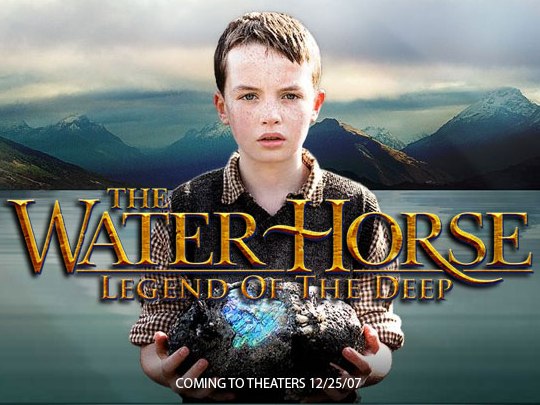
+++
Text © 2003, 2007. Loren Coleman and Patrick Huyghe. All rights reserved.
Cartoons © A G Harmsworth.
St. Columba art © William Rebsamen.
+++
About Loren Coleman
Loren Coleman is one of the world’s leading cryptozoologists, some say “the” leading living cryptozoologist. Certainly, he is acknowledged as the current living American researcher and writer who has most popularized cryptozoology in the late 20th and early 21st centuries.
Starting his fieldwork and investigations in 1960, after traveling and trekking extensively in pursuit of cryptozoological mysteries, Coleman began writing to share his experiences in 1969. An honorary member of Ivan T. Sanderson’s Society for the Investigation of the Unexplained in the 1970s, Coleman has been bestowed with similar honorary memberships of the North Idaho College Cryptozoology Club in 1983, and in subsequent years, that of the British Columbia Scientific Cryptozoology Club, CryptoSafari International, and other international organizations. He was also a Life Member and Benefactor of the International Society of Cryptozoology (now-defunct).
Loren Coleman’s daily blog, as a member of the Cryptomundo Team, served as an ongoing avenue of communication for the ever-growing body of cryptozoo news from 2005 through 2013. He returned as an infrequent contributor beginning Halloween week of 2015.
Coleman is the founder in 2003, and current director of the International Cryptozoology Museum in Portland, Maine.
Filed under Cryptomundo Exclusive, Cryptotourism, CryptoZoo News, Cryptozoologists, Cryptozoology, Eyewitness Accounts, Lake Monsters, Loch Ness Monster, Movie Monsters